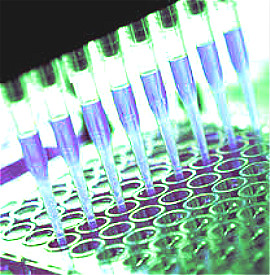The Benefits and Process of Assays
As mentioned before, ELISA is a vital technology in immunoassay and it has been applied to diagnosis of contagion, parasitosis,  non-infectious disease caused by pathogenic microorganism. It also has been applied to quantitative assay of macromolecular antigens and micromolecular antigens. What’s more, ELISA is suitable to not only examination of clinical specimens but also to sero-epidemiological investigation. In addition, it can be used as antibody assay as well as assaying circulating antigen of humoral fluids. Thus it is also a good method to early diagnosis. All the benefits of ELISA make its application area expand in biomedicine. There are some advantages of ELISA in some specific assays.
non-infectious disease caused by pathogenic microorganism. It also has been applied to quantitative assay of macromolecular antigens and micromolecular antigens. What’s more, ELISA is suitable to not only examination of clinical specimens but also to sero-epidemiological investigation. In addition, it can be used as antibody assay as well as assaying circulating antigen of humoral fluids. Thus it is also a good method to early diagnosis. All the benefits of ELISA make its application area expand in biomedicine. There are some advantages of ELISA in some specific assays.
HCV(hepatitis C virus) antibody assay
When do HCV antibody assay, it is advised to take double-antibody sandwich of ELISA for its benefits.
First, the reagent of double-antibody sandwich does not require diluting serum sample and it owns high specificity free from disturbance of RF(rheumatoid factors).
Second, the reagents can test all kinds of antibodies in serum especially IgM antibody. Thus the Window Period from getting virus infection to assaying the antibody by ELISA can be shorten.
Third, utilizing biotinylated antigen to bind combination of avidin and enzyme can make responding signals amplified. Thus sensitivity of assay will improved.
ELISA(Enzyme-Linked Immunosorbent Assay) for Lyme Disease
There was a experiment which aimed to estimate the sensitivity and specificity of ELISA for Lyme disease . There is the assay process:
First, examined serum from patients with Lyme disease, patients who had other infectious disease, and healthy individuals.
Then, important cross-reactivity happened only with serum from patients with syphilis, yaws, and pinta. All tested serum of patients who had Lyme disease, however, didn’t have the positive results in the rapid reagin screening.
Later, when serum of patients who owned treponemal diseases were excluded from the analysis, the ELISA were highly specific for owning 96% and 100% reliability.
Conclusion :The test’s Sensitivity differed with the different stage of disease but it was 100% for the test during complicated Lyme disease. The result shows that the ELISA is very suitable for complicated Lyme disease for its high specificity and sensitivity.
As an vital technology in immunoassay, ELISA has got a lot of praise from the magazines and the internet.
Enzyme-linked immunosorbent assays (ELISA) have been around as one of the primary methods of analyte detection for more than four decades. Over the years many changes to the basic format have resulted in assay improvements, but some of the most recent look set to take the traditional ELISA to new levels. —-Drug Discovery World[1]
The most powerful ELISA assay format is the sandwich assay. This type of capture assay is called a Researchers provide an assay chemistry that allows for a direct visual scoring of an ELISA result to detect protein analytes at ultralow concentrations.–Gen[2]
Reference:
[1] Dr John Comley, ELISA ASSAYS recent innovations take analyte detection to new levels, Drug Discovery World, fall, 2012.
[2] Anton Simeonov, Ph.D. Literature Review: ELISA—Detected Through A Quick Glance, Gen, Feb 7, 2013.
